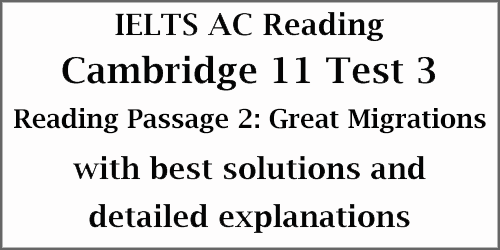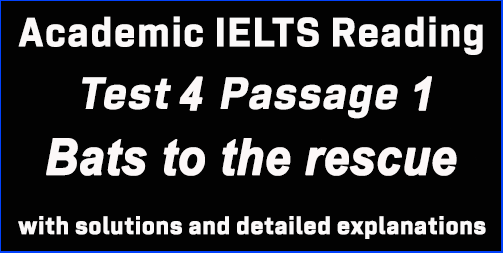IELTS Academic Reading: Cambridge 11 Test 3 Reading passage 2; Great Migrations; with best solutions and detailed explanations
This IELTS Reading post is the second of the series post deals with the best solutions for Cambridge IELTS 11 Reading Test 3 Passage 2 which is titled ‘Great Migrations’. This is another targeted post for candidates who have great problems in finding and understanding IELTS Reading Answers. This post can easily guide you the best to figure out every Reading answer without any difficulty. Finding IELTS Reading answers is a step-by-step routine and I hope this post can assist you in this topic.
IELTS AC Reading: Cambridge 11 Test 3
Reading Passage 2:
The headline of the passage: Great Migrations
Questions 14-18: TRUE, FALSE, NOT GIVEN
[In this type of question, candidates are asked to find out whether:
The statement in the question agrees with the information in the passage – TRUE
The statement in the question contradicts with the information in the passage – FALSE
If there is no information on this – NOT GIVEN
For this type of question, you can divide each statement into three independent pieces and make your way through with the answer.]
Question 14: Local gulls and migrating arctic terns behave in the same way when offered food.
Keywords for the question: local gulls, migrating arctic terns, behave, same way, offered food,
In paragraph no. 2, the first few lines indicate the answer, “An arctic tern, on its 20,000 km flight from the extreme south of South America to the Arctic circle, will take no notice of a nice smelly herring offered from a bird-watcher’s boat along the way. While local gulls will dive voraciously for such handouts, the tern flies on. .. ..”
The lines suggest that local gulls will be attracted to food offered while arctic terns will not pay attention to food when migrating; they behave differently.
So, the answer is: FALSE
Question 15: Experts’ definitions of migration tend to vary according to their area of study.
Keywords for the question: experts’ definitions, migration, tend to vary, area of study,
In paragraph no. 4, take a look at the first few lines, “But migration is a complex issue, and biologists define it differently, depending in part on what sorts of animals they study. .. .”
Here,biologists = experts, define = definitions, differently = vary, depending in = according to, what sorts of animals they study = their area of study,
So, the answer is: TRUE
Question 16: Very few experts agree that the movement of aphids can be considered migration.
Keywords for the question: very few experts, agree, movement, aphids, can be considered, migration,
We find the mention of aphids’ movement in paragraph no. 5, “But daily vertical movements by zooplankton in the ocean – upward by night to seek food, downward by day to escape predators – can also be considered migration. So can the movement of aphids when, having depleted the young leaves on one food plant, their offspring then fly onward to a different host plant, with no one aphid ever returning to where it started.”
However, no comparison has been made on experts’ opinion about aphids’ movement considered as migration.
So, the answer is: NOT GIVEN
Question 17: Aphids’ journeys are affected by changes in the light that they perceive.
Keywords for the question: Aphids’ journey, affected, changes, light, they perceive,
In paragraph no. 6, the answer to this question can be traced in lines 6-11, “ . .. . They allow for the fact that, for example, aphids will become sensitive to blue light (from the sky) when it’s time for takeoff on their big journey, and sensitive to yellow light (reflected from tender young leaves) when it’s appropriate to land. .. .”
Here, when it’s time for takeoff on their big journey = aphids’ journey, will become sensitive to blue light & sensitive to yellow light = affected by changes in the light,
So, the answer is: TRUE
Question 18: Dingle’s aim is to distinguish between the migratory behaviours of different species.
Keywords for the question: Dingle’s aim, distinguish, migratory behaviours, different species,
In paragraph no. 6, the answer is found in the last few lines “.. .. The value of his definition, Dingle argues, is that it focuses attention on what the phenomenon of wildebeest migration shares with the phenomenon of the aphids, and therefore helps guide researchers towards understanding how evolution has produced them all. ..”
This means the aim of Dingle is to focus attention on the similarities between wildebeest migration and aphid migration, not to distinguish the migratory behaviours of different species.
So, the answer is: FALSE
Questions 19-22: Completing/Matching sentences with correct endings
[For this type of question, candidates need to match the beginning and end of sentences. Candidates need to look for keywords in the sentence-beginnings and find the relative paragraphs and then sentences in the passage. Skimming and scanning, both reading skills are essential for this question-type.]
Question 19: According to Dingle, migratory routes are likely to –
Keywords for the question: Dingle, migratory routes, likely to,
Take a look at lines 8-13 of paragraph no. 1, “ . .. . The biologist Hugh Dingle has identified five characteristics that apply, in varying degrees and combinations, to all migrations. They are prolonged movements that carry animals outside familiar habitats; they tend to be linear, . .. .”
Here, tend to = likely to, linear = follow a straight line,
So, the answer is: G (follow a straight line.)
Question 20: To prepare for migration, animals are likely to –
Keywords for the question: prepare, migration, animals, likely to,
Again, in paragraph no. 1 at lines 14-16, the writer says, “ . .. . they involve special behaviours concerning preparation (such as overfeeding) and arrival; .. .”
Here, preparation = to prepare for migration, overfeeding = eat more than they need,
So, the answer is: C (eat more than they need for immediate purposes.)
Question 21: During migration, animals are unlikely to –
Keywords for this question: during, migration, animals, unlikely to,
In paragraph no. 1, the writer mentions in lines 17-22, “ .. . And one more: migrating animals maintain an intense attentiveness to the greater mission, which keeps them undistracted by temptations and undeterred by challenges that would turn other animals aside.”
Here, undeterred = unlikely to be discouraged, challenges = difficulties,
So, the answer is: A (be discouraged by difficulties.)
Question 22: Arctic terns illustrate migrating animals’ ability to –
Keywords for this question: Arctic terns, illustrate, migrating animals’ ability,
The answer is in lines 1-5 of paragraph no. 2, “An arctic tern, on its 20,000 km flight from the extreme south of South America to the Arctic circle, will take no notice of a nice smelly herring offered from a bird-watcher’s boat along the way. . .. .”
Here, will take no notice of = ignore, nice smelly herring (food) = distractions,
So, the answer is: E (ignore distractions.)
Question 23-26: Summary completion with ONE word only
[In this kind of question candidates are given a summary for one, two or three paragraphs with some fill in the blanks questions. As these are fill in the blanks or gaps, there is a condition of writing ONE, TWO or THREE words for each answer. Candidates need to find out the related paragraphs by correctly studying the keywords form the questions. Then, they should follow the steps of finding answers to fill in the gaps.]
Title of the summary: The migration of pronghorns
Question 23: Pronghorns rely on their eyesight and _________ to avoid predators.
Keywords for this question: Pronghorns, rely on, eyesight, to avoid, predators,
Let’s take a look at paragraph no. 7 (where the writer talks about the Pronghorns) in lines 24-25, “ .. . Pronghorn, dependent on distance vision and speed to keep safe from predators, .. . .”
Here, dependent on = rely on, vision = eyesight, keep safe = avoid,
So, the answer is: speed
Question 24: One particular population’s summer habitat is a national park, and their winter home is on the _________ where they go to avoid the danger presented by the snow at that time of year.
Keywords for this answer: one particular population’s summer habitat, national park, winter home, where, go, avoid, danger, snow,
The answer can be found in paragraph no. 7 in lines 6-12, “ .. . One population, which spends the summer in the mountainous Grand Teton National Park of the western USA, follows a narrow route from its summer range in the mountains, across a river, and down onto the plains. Here they wait out the frozen months, feeding mainly on sagebrush blown clear of snow. … .”
Here, One population = one particular population, spends the summer = summer habitat, Grand Teton National Park = national park, they wait out the frozen months = their winter home,
So, the answer is: plains
Question 25: However, their route between these two areas contains three ________.
Keywords for this answer: their route, these two area, contains, three,
In paragraph no. 7, lines 13-16 say, “. .. . These pronghorn are notable for the invariance of their migration route and the severity of its constriction at three bottlenecks. .. . .”
Here, route = migration route,
So, the answers are: bottlenecks
Question 26: One problem is the construction of new homes in a narrow __________ of land on the pronghorns’ route.
Keywords for this answer: one problem, construction of new homes, narrow, land, pronghorns’ route,
Take a close look at the last few lines of paragraph no. 7, “ . .. At one of the bottlenecks, forested hills rise to form a V, leaving a corridor of open ground only about 150 metres wide, filled with private homes. Increasing development is leading toward a crisis for the pronghorn, threatening to choke off their passageway.”
Here, a crisis = one problem, Increasing development = construction of new homes, only about 150 metres wide = narrow,
So, the answers are: corridor/passageway
Click here for solutions to Cambridge 11 Academic Reading Test 3 Passage 1
Click here for solutions to Cambridge 11 Academic Reading Test 3 Passage 3




Salifu
I am completely dissatisfied with question no. 18th
In the passage there is no mention about his aim
Very stupid!
And this comment is for Cambridge not for ielts deal
Question no 23,24,25 no following order. I was searching the answer of 24, 25 and wasted all the allocated time. After that I found it was before answer of question no 23. What the hell. Even for some other question I found the issue. No order. Is it something like, Reading test not gonna be follow the order. What a mess
I love it
I understand it
Thank you